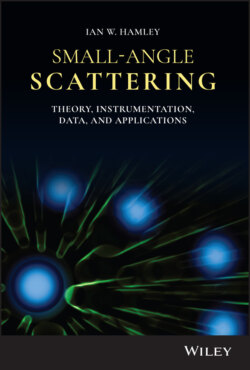Читать книгу Small-Angle Scattering - Ian W. Hamley - Страница 20
1.6.3 Partially Ordered Systems and Paracrystals
ОглавлениеThe number of observed reflections as well as the peak width for an ordered structure gives an indication of the extent of order. Figure 1.10 illustrates this schematically for a one‐dimensional lattice with variable degrees of short‐ or long‐ranged order [20, 30].
Figure 1.10 Long‐range versus short‐range order showing schematics of real space distribution functions g(r) (left), and scattered intensity profiles I(q) (right). (a) Long-range order, (b) Quasi-long-range order, (c) Short range order.
For the case of a crystalline sample with long‐range positional order, the scattering pattern will consist of a function of sharp resolution‐limited diffraction peaks, as shown in Figure 1.10a. Thermal disorder leads to peak attenuation described (in the case of isotropic disorder) by a Debye‐Waller factor, , where 〈u2〉 is the mean‐squared displacement from the scattering centre.
For a sample with quasi‐long‐range order, the scattering profile consists of a sharp peak with power‐law tails (Figure 1.10b). More commonly observed is short‐range order. This produces a scattering profile containing a Lorentzian peak (Figure 1.10c) given by
(1.57)
Here ξ is a correlation length and q0 = 2π/d is the peak position (d is the preferred spacing in the system). If the decay of the peaks in the correlation function is steeper, g(r) ∼ exp(−r2/ξ2), then the intensity profile shows a Gaussian peak:
(1.58)
For more ordered or partly crystalline materials, paracrystal models can be employed in the analysis of SAS data. Paracrystals are imperfect crystals in which a degree of lattice order is retained. Figure 1.11 illustrates paracrystals of the first and second kind, for the case of a two‐dimensional lattice.
Figure 1.11 Schematic of lattice distortions in paracrystals with lattice distortions of (a) first and (b) second kind.
In a paracrystal with imperfections of the first kind, the long‐range lattice order is retained but there are fluctuations in position around the lattice nodes (Figure 1.11a), i.e. there is positional disorder. In the observed diffraction pattern, the peak width increases linearly with the peak order [31], and the intensity is modulated by a Debye‐Waller factor as described above [12, 31]. With lattice distortions of the second kind, the long‐range lattice order is disrupted as shown in Figure 1.11b, i.e. there is long‐range positional and bond orientational disorder. This leads to a quadratic increase in peak width with peak order [12, 31]. Analytical solutions are available for one‐dimensional paracrystal models of the first and second kind [12, 22].
